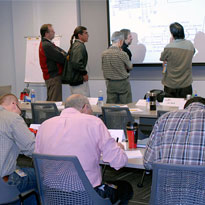LTE: RF Network Design
- Course:LTE: RF Network Design
- Course ID:LTEWK Duration:5 days Where: Your Office (7+ Persons)
- Download Course Description (PDF)
Available as a private, customized course for your group at your offices or ours and in some cases as a WebLive(TM) class.
Course Outline
- Evolution of Mobile Radio
- The Basic Concepts of Cellular Radio
- GSM Network Architecture
- The GSM Air Interface: Channels and Access Techniques
- GSM/GPRS and Packet-based Access
- UMTS: The Evolution of GSM RAN and Core Network
- LTE Technology Overview
- LTE: The Evolutionary Next Step in Cellular Radio
- The LTE Frame Architecture
- LTE Physical Channels
- Accessing LTE Network
- The eUTRAN Components and Protocol Stack
- LTE Air Interface Variations
- LTE vs. Mobile WiMAX for 4G
- Service Architecture Evolution (SAE)
- LTE/SAE Core Network Evolution
- Components of the Evolved Packet Core (EPC)
- SAE/EPC Reference Points and Interfaces
- Interworking with Other Technologies
- Review of RF Fundamentals for LTE
- Basic Radio Link Considerations (link budget margins)
- Basics of Information Transfer for Radio
- Working with Decibels
- Digital Modulation Techniques for LTE
- Error Correction Techniques for LTE
- Antenna Considerations for LTE
- General Antenna Types and Characteristics
- Antenna Diversity Techniques
- Advanced Antennas for LTE
- LTE Link Budget Analysis
- Equipment: Parameters and Configuration
- Link Margins and Service Objectives
- Receive System Performance Analysis
- Co-location Issues for LTE
- Developing a Link Budget
- Path Loss Modeling: LOS and NLOS
- Radio Propagation Mechanisms
- Free Space Path Loss Analysis for Line-of Sight
- Modeling Non-Line-of-Sight Path Loss
- Semi-empirical Path Loss Models
- 3GPP and ITU Proposed Path Loss Models
- LTE and the NLOS Environment
- Impairments Due to Multipath in the NLOS Environment
- The Wide-band Channel and Inter-symbol Interference (ISI)
- Mitigating ISI with OFDM
- S-OFDMA: Balancing ISI and Doppler
- The LTE Downlink: S-OFDMA
- Reducing PAPR with SC-FDMA for the LTE Uplink
- Frequency Reuse Techniques for LTE
- Overview of Frequency Reuse
- LTE and Fractional Frequency Reuse (FFR)
- Interference Margins on LTE
- Inter Cell Interference Considerations
- ICIC Optional Feature Discussions
- Inter Cell Estimations: Mathematical Modeling
- Inter Cell Estimations: Simulators
- Exercises: Excel-based Practical Tool
- Scheduler Functionality on LTE
- Inter Cell Interference Considerations
- Scheduler Decisions and Inter Cell Interference Influence
- Average Throughput vs. SINR (γ) Estimations: Mathematical Modeling
- Average Throughput vs. SINR (γ) Estimations: Simulations
- Exercises: Excel-based Practical Tool
- The “Flat Earth” Model: Engineering and Business
- Balancing Engineering and Business Needs
- The “Flat Earth “ Model for LTE
- Moving from “Flat Earth” to Real World
- High Bit Rate Backhaul Options for LTE
- Oversubscription and Traffic Engineering
- Capacity, Oversubscription, Utilization and Delay
- Modeling a Single-server System: An LTE Backhaul
- Modeling a Multi-server System: An LTE Sector
- Modeling an LTE Deployment Environment
- Required Data for Modeling the Real World
- Selecting a Propagation Model: Physical vs. Empirical
- Setting up a Modeling Tool: Environment and Site Configuration
- Performing a Coverage Study with a Modeling Tool
- Course Wrap-up: Recap and Discussion
Course in a Nutshell
This workshop seeks to equip you with an in-depth understanding of the technical aspects of LTE/SAE necessary for the design, analysis and deployment of this exciting new radio technology.
The initial portion of this course presents an overview of basic core network and air interface standards including system components, reference points, protocol stacks and fundamental concepts that form the basis for the rest of the course. Each module of this course builds upon the previous modules, culminating in the use of a propagation modeling tool to estimate the performance of an LTE network, based on equipment specifications, system configuration and environmental variables. This how-to course, emphasizing calculator exercises and detailed analysis using the spreadsheets included in the course, will help you learn practical techniques that you can put to immediate use on your job.
Customize It!
If you would like to take this course but don’t have the requisite understanding of WCDMA/LTE, we can extend the course to include an up-front overview of WCDMA/LTE. The course may also be customized to your project requirements or operational environment.
Learn How To
- Describe the evolution of mobile radio from 2G to LTE
- Compare LTE to 3G (WCDMA) and 4G (WiMAX) technologies
- Describe the basic LTE frame structure and function
- Explain the function of the LTE eUTRAN reference points
- Describe the basic function of the LTE/SAE protocol stack
- Discuss the benefits and limits of MIMO and Adaptive Arrays for LTE
- Perform an LTE link budget analysis using equipment specifications
- Estimate path loss using both physical and empirical models
- Discuss the advantages and disadvantages of OFDM/OFDMA in a NLOS environment
- Explain the use of SC-FDMA for amplifier efficiency on the LTE uplink
- Describe Fractional Frequency Reuse (FFR) approaches for LTE
- Describe the timing options available for LTE deployments
- Perform a “Flat-Earth” analysis to evaluate RF design viability
- Compare different approaches for backhauling LTE sites
- Compare the use of oversubscription to traffic engineering rules
- Model LTE coverage based on C/(I+N) for different Modulation/FEC
Aimed At
Technical audiences with prior understanding of WCDMA and some exposure to LTE who need a workshop-style course on the LTE radio network design issues.
Prerequisites
The LTE overview course is strongly recommended, though not required.

